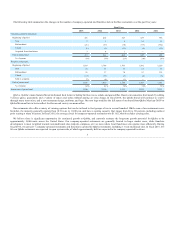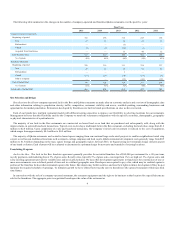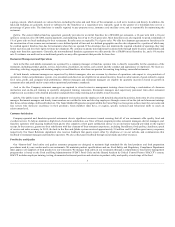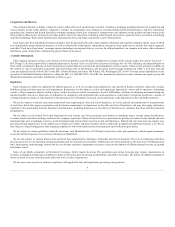Jack In The Box 2015 Annual Report Download - page 15
Download and view the complete annual report
Please find page 15 of the 2015 Jack In The Box annual report below. You can navigate through the pages in the report by either clicking on the pages listed below, or by using the keyword search tool below to find specific information within the annual report.
and service offerings and engaged in substantial price discounting in the past, and may adopt similar strategies in the future. In an effort to increase same-
store sales, we continue to make improvements to our facilities, to implement new service and training initiatives, and to introduce new products and
discontinue other menu items. However, there can be no assurance that our facility improvements will foster increases in sales and yield the desired return on
investment, that our service initiatives or our overall strategies will be successful, that our menu offerings and promotions will generate sufficient customer
interest or acceptance to increase sales, or that competitive product offerings, pricing and promotions will not have an adverse effect upon our margins, sales
results and financial condition. In addition, the success of our strategy depends on, among other factors, our ability to motivate restaurant personnel and
franchisees to execute our initiatives and achieve sustained high service levels.
Advertising and Promotion Risks. Some of our competitors have greater financial resources, which enable them to purchase significantly more
advertising, particularly television and radio ads, than we are able to purchase. Should our competitors increase spending on advertising and promotion, or
should the cost of advertising increase or our advertising funds decrease for any reason, including reduced sales or implementation of reduced spending
strategies, or should our advertising and promotion be less effective than our competitors, there could be a material adverse effect on our results of operations
and financial condition. The growing prevalence and importance of social media platforms and mobile technology also pose challenges and risks for our
marketing, advertising and promotional strategies. Failure to effectively use these platforms or technology could cause our advertising to be less effective
than our competitors. Moreover, improper or damaging use of social media or mobile technology by our employees, franchisees, or guests could increase the
Company’s costs, lead to litigation or result in negative publicity that could also have a materially adverse effect on our results.
Taxes. Our income tax provision is sensitive to expected earnings and, as those expectations change, our income tax provisions may vary from quarter-to-
quarter and year-to-year. In addition, from time to time, we may take positions for filing our tax returns that differ from the treatment for financial reporting
purposes. The ultimate outcome of such positions could have an adverse impact on our effective tax rate.
Risks Related to Reducing Operating Costs. In recent years, we have identified strategies and taken steps to reduce operating costs to align with the
increased Jack in the Box franchise ownership and to further integrate Jack in the Box and Qdoba brand restaurant systems. These strategies include
outsourcing certain functions, reducing headcount, and integrating restaurant information systems between our brands. We continue to evaluate and
implement further cost-saving initiatives. However, the ability to reduce our operating costs through these initiatives is subject to risks and uncertainties, and
we cannot assure that these activities, or any other activities that we may undertake in the future, will achieve the desired cost savings and efficiencies.
Failure to achieve such desired savings could adversely affect our results of operations and financial condition.
Risks Related to Loss of Key Personnel. We believe that our success will depend, in part, on our ability to attract and retain the services of skilled
personnel, including key executives. The loss of services of any such personnel could have a material adverse effect on our business.
Risks Related to Government Regulations, Including Regulations Increasing Labor Costs. The restaurant industry is subject to extensive federal, state
and local governmental regulations as described in Item 1 under “Regulation.” We are subject to rules and regulations including but not limited to those
related to:
• the preparation, ingredients, labeling, packaging, advertising and sale of food;
• building and zoning requirements;
• sanitation and safety standards;
• employee healthcare, including the implementation and legal, regulatory and cost implications of the Affordable Care Act;
• labor and employment, including minimum wage adjustments, overtime, working conditions, employment eligibility and documentation, sick
leave, and other employee benefit and fringe benefit requirements, and changing judicial, administrative or regulatory interpretations of federal or
state labor laws;
• the registration, offer, sale, termination and renewal of franchises;
• truth-in-advertising, consumer protection and the security of information;
• Americans with Disabilities Act;
• payment cards;
• liquor sales; and
• climate change, including the potential impact of greenhouse gases, water consumption, or a tax on carbon emissions.
The increasing amount and complexity of regulations and their interpretation may increase the costs to us and our franchisees of labor and compliance,
and increase our exposure to legal and regulatory claims which, in turn, could have a material adverse effect on our business. While we strive to comply with
all applicable existing statutory and administrative rules, we cannot predict the effect on operations from issuance of additional requirements in the future.
13
























